Instructional Design Resources
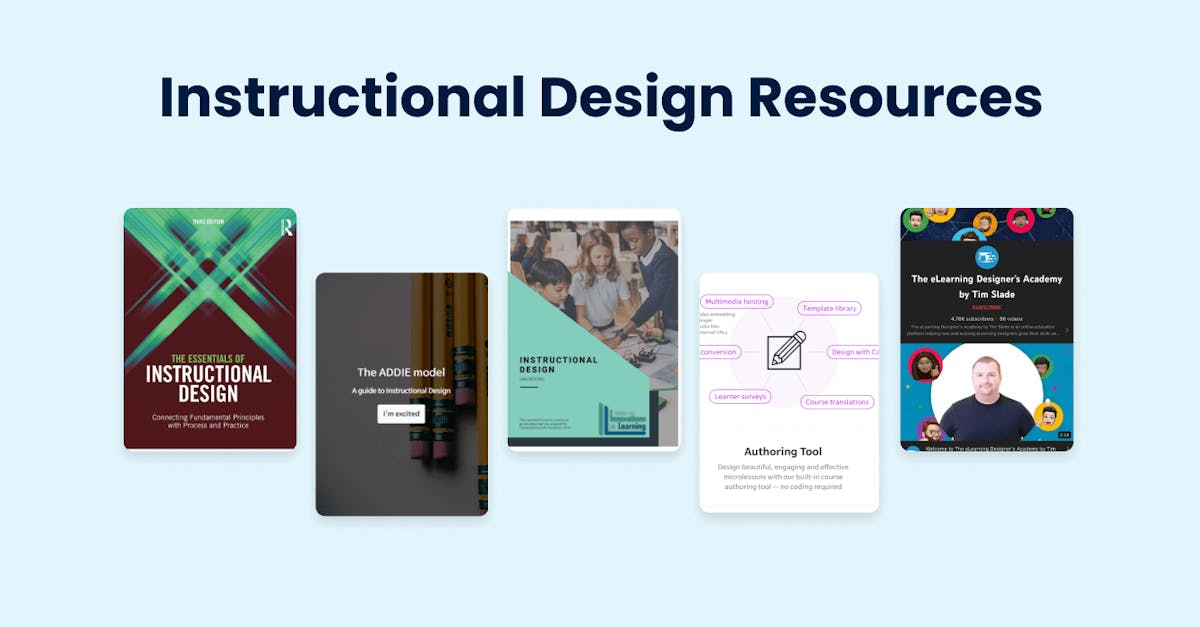
Having access to instructional design resources is helpful when you’re creating quality content. There are different ways to build instructional materials, from learning the theories to applying advanced techniques in today’s digital technologies. Here are some of the instructional design resources to help you get started.
1. Instructional Design by EdApp
This Instructional Design course available on EdApp is all about using the ADDIE model, which stands for Analyze, Design, Develop, Implement and Evaluate. It starts by talking about the objectives of the ADDIE model, which is all about establishing the training needs and subsequent skills of learners. This course teaches how to use ADDIE as a guide when it comes to instructional design, and details how each phase can be implemented. At the end of this course, instructional designers will be able to apply the ADDIE model when developing and designing courses and determine if this approach works.
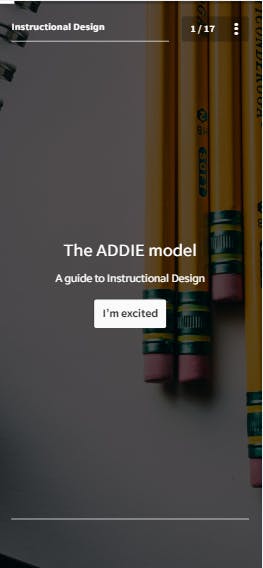
This course uses a microlearning design model which bunches key information into easily-digestible chunks. It’s the most effective strategy for training that covers crucial and in-depth topics like OSHA training, HAZPOWER training, safety training, and more. Presenting learning content this way increases the chances of knowledge retention and the transfer of information from short-term to long-term memory.
- Cost: Free
- Resource Type: Mobile course
- Key Topics: ADDIE Model, instructional analysis, implementation phase
2. EdApp Instructional Design Tool
EdApp is an LMS and elearning authoring software that specializes in instructional design building. With its intuitive course authoring tool, instructional designers can easily build their own materials in no time. Aside from that, EdApp also boasts over 80 microlearning templates that are sure to engage your learners as it uses game-like elements, quizzes, and creative ways to present learning content. Instructional designers have the option to choose among the customizable templates and edit them as they see fit to increase the chances of knowledge retention as compared to content that doesn’t use microlearning techniques. There’s also a handy Canva integration right in the authoring tool so you can use and import graphics, imagery, and more to spice up your lessons.
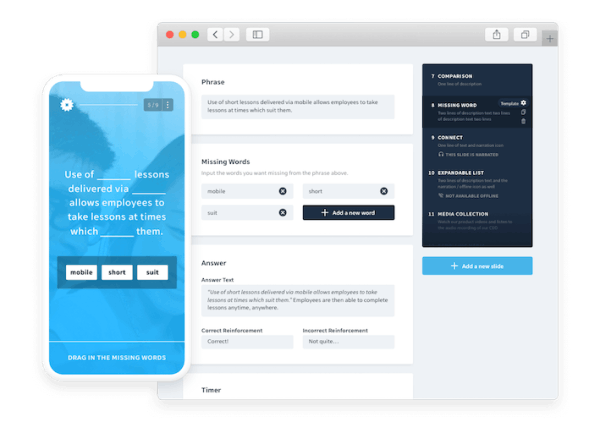
If you’re creating courses for teams spread across the globe, there’s no need to worry about hiring a translator or looking for third-party translation tools. EdApp has its own translation tool which can automatically translate into 100+ different languages with a 60-70% accuracy rate.
- Cost: Free
- Resource Type: Authoring tool
- Key Features: Microlearning templates, Canva integration, AI translation
3. What is Instructional Design? by Ray Pastore, Ph. D.
This YouTube series walks instructional designers through each phase of instructional design from start to finish. The first videos define what instructional design is and what exactly an instructional designer does. Then, learners will be guided every step of the way, from learning how to create a course outline and how to write course objectives, to using instructional strategies, creating style guides and storyboards, and using different approaches. Ray Pastore also shares tips and tricks based on his years of experience with instructional design, along with other helpful resources.
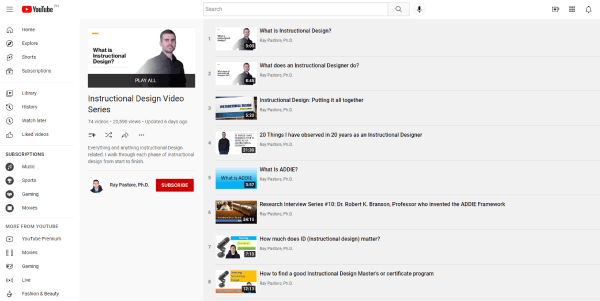
- Cost: Free
- Resource Type: Video series
- Key Topics: Definition of instructional design, instructional designer role, instructional design strategies
4. Learning to Teach Online by Coursera
Coursera’s Learning to Teach Online is a course intended for those who want to gain a deeper understanding of instructional design strategies and approaches that they can use to achieve better online learning outcomes. It first discusses the importance of online learning and how the technologies we have today help make it possible. It then delves into how you can effectively plan your online learning along with the tools and considerations you need to weigh for the best learning experience. It then talks about how your curriculum design, activity structure, and the relevance of the chosen technology play a big role in keeping your learners engaged and motivated even from a distance.

- Cost: Free
- Resource Type: Online course
- Key Topics: Importance of online learning, planning online learning, curriculum design
5. The Online Course Model: How to Create an Online Course that Actually Works by SkillShare
Next on our list is another instructional design course created by Aimee Prasek Ph.D., an online course researcher and consultant who will walk instructional designers through her six-phased system of online course creation. It starts by highlighting the importance of having a purpose statement when designing a course and identifying what problems it will solve. It also talks about how research is crucial when developing your courses and how the type of learners will determine what approach to use. This course is delivered through a series of actionable videos and also includes a comprehensive course workbook as a bonus. To take this course though, you’ll need to subscribe to SkillShare, which will also give you access to hundreds of courses on their website.

- Cost: US 59/user/year subscription
- Resource Type: Online course
- Key Topics: Phases of online course creation, creating a purpose statement, validating research
6. The Essentials of Instructional Design by Abbie H. Brown and Timothy D. Green
The Essentials of Instructional Design is intended for new or budding instructional designers. Here, they’ll be introduced to the essential elements of instructional design and the key procedures within the instructional design process. It discusses the different models that they can use, such as the ADDIE model, the pie model, and the diamond model. The strengths and challenges of each approach will also be discussed so instructional designers can determine what works best to meet their learning objectives. They’ll also learn how to evaluate the success of their instructional design process so it can be improved and changed as needed.
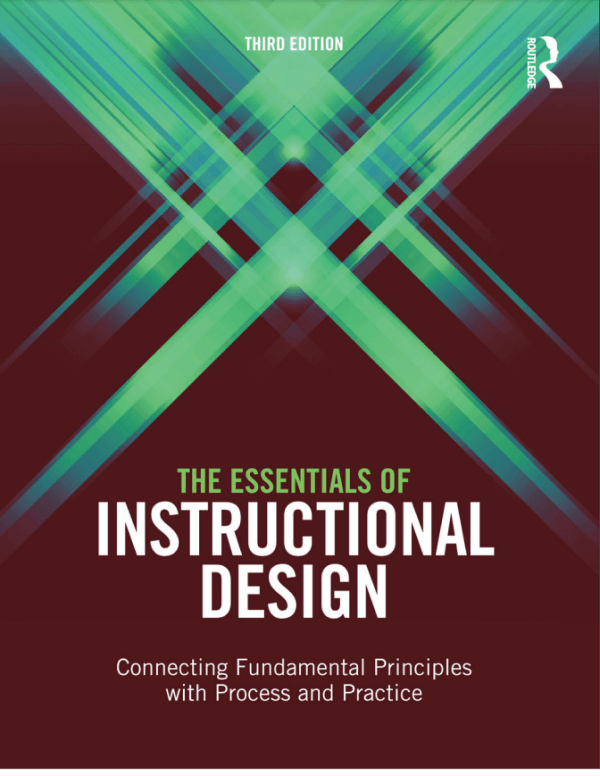
- Cost: Free
- Resource Type: PDF file
- Key Topics: Instructional design models, elements of instructional design, instructional design evaluation
7. The eLearning Designer’s Academy by Tim Slade
Another YouTube video series that is a great instructional design resource is Tim Slade’s The eLearning Designer’s Academy. With a decade of experience, Tim teaches instructional designers how to hone their skills and create eLearning that gets results. Videos included in this series talk about essential topics, such as creating an eLearning course outline, conducting a needs analysis, and using different models like ADDIE and SAM. He also has tutorial videos like knowing when to use click-to-reveal interactions or designing better navigational elements in your lessons. In his videos, he’ll also show different tools that he uses such as Articulate and PowerPoint to familiarize instructional designers and help them make a choice on which best to use.

- Cost: Free
- Resource Type: Video series
- Key Topics: Creating a course outline, conducting a needs analysis, instructional design models, instructional design tools
8. Instructional Design Principles to Create Successful E-Learning Courses by Alison
Alison’s instructional design course equips instructional designers with the skills and tools they need to develop quality courses. It starts with introducing the various learning theories and how they can help with retention and learning. It then goes into how you can design instructionally-sound courses by creating your learning objectives, conducting a needs analysis, and storyboarding. As interactivity is a key component in keeping learners engaged, the final lesson talks about using interactive elements, such as videos, audio, and graphics.
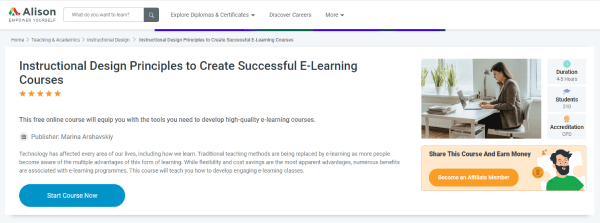
- Cost: Free
- Resource Type: Online course
- Key Topics: Learning theories, creating learning objectives, conducting needs analysis, using interactive elements in course development
9. Instructional Design by Sam Redding
The Instructional Design PDF by Sam Redding focuses on how instructional design can play a part to boost personalized learning. It talks about how you can infuse personalization strategies with your instructional design by outlining the aspects of instruction and determining key parts to include in a lesson. Here, instructional designers will be asked to reflect on the types of learning activities they can include where the learners engage in these activities. It also considers the pace of instruction along with the amount of instruction and practice. As it’s important that goals and objectives are met and measured, it also goes into having evaluation metrics to go hand in hand with tracking progress and performance.

- Cost: Free
- Resource Type: PDF file
- Key Topics: Personalization strategies, types of learning activities, key parts of a lesson
10. Instructional Design and Technology Micromasters by edX
edX’s Micromasters program in Instructional Design and Technology aims to train students to become familiar with the different instructional design tools and techniques for creating content. It includes learning theory and instructional design models, where learners can mix traditional and digital approaches. Learners can also identify emerging technologies that they can use and fit their design implementation process. To evaluate the success of the course, data mining techniques will also be tackled to measure training metrics and see how effective the learning experience is. This course is entirely online and can be completed in 8 months. It’s an instructor-led program and is not self-paced which might not be advantageous for those with tight schedules.
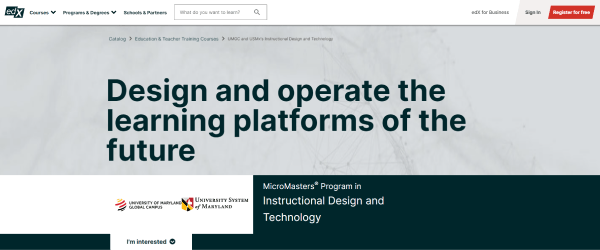
- Cost: Free
- Resource Type: Online course
- Key Topics: Learning theories, instructional design models,
Author
Gabrielle Rivera
Gabrielle is an eLearning content writer for EdApp, a microlearning solution designed for today's digital habits. She creates content about cutting-edge learning technologies and resources to help companies deliver great training experiences. When not absorbed in writing, she spends her time playing video games and reading books.
